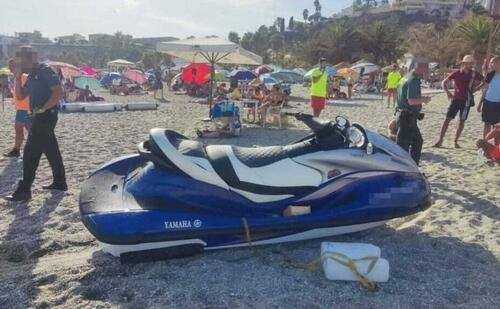
Authored by John Cody via Remix News,
Boats are passé for migrants with money, who are now turning to jet skis to zip across the Mediterranean...
What may look like a well-off tourist enjoying a jet ski ride off the coast of Spain may actually be an illegal immigrant with enough money to afford the trip.
The use of jet skis by migrants to enter Spain illegally from Moroccan shores has gained momentum in recent months. According to the Bladi news outlet, the country’s security forces have difficulty detecting these devices on radar, which makes it difficult to apprehend migrants and human smugglers.
“In recent weeks, the arrivals of Moroccans to the peninsula using jet skis have multiplied. These devices are used by criminal organizations dedicated to human trafficking that charge up to €10,000 euros per ticket,” Civil Guard sources told El Confidencial.
Law enforcement sources describe the migrants as “victims” of criminal networks that are promoting jet skis as an effective way to reach European shoes. They say these migrants “are not aware of the danger to which they expose themselves by embarking on such a journey because jet skis work in a specific manner, which varies according to the number of occupants, the speed, and the waves.”
While jet skis are expensive to purchase and carry their own risks to operate on the open ocean, their small size and agility presents an enticing option for migrants with enough money to afford the trip.
While Spain has long struggled with illegal immigration flows from North Africa, the greatest focus this year has been on the Balkan route, far from the Spanish coast, with Hungary reporting it has apprehended over 200,000 migrants this year alone. Germany and Austria are also seeing more migrants arriving than even during the height of the migrant crisis in 2015 and 2016, but the crisis in Ukraine has also played a large role in the influx. In contrast, Spain has been able to slightly reduce migratory flows since the country changed its diplomatic position on the Sahara conflict in March, and due to the strengthening of control by Moroccan authorities on its coastline.
Law enforcement reports that human trafficking networks are adapting and have taken over the various migratory routes to Ceuta, Melilla, the Canary Islands, the Andalusian coast, and the Balearic Islands.
According to data published by the Spanish Ministry of the Interior, 23,197 migrants arrived in Spain in the first nine months of 2022, compared to 28,729 in the same period of 2021. On the other hand, the migratory flow has unexpectedly increased by over 23 percent through land routes, including via Ceuta and Melilla, in the first three quarters of this year, reaching 1,969 migrants.
Authored by John Cody via Remix News,
Boats are passé for migrants with money, who are now turning to jet skis to zip across the Mediterranean…
What may look like a well-off tourist enjoying a jet ski ride off the coast of Spain may actually be an illegal immigrant with enough money to afford the trip.
The use of jet skis by migrants to enter Spain illegally from Moroccan shores has gained momentum in recent months. According to the Bladi news outlet, the country’s security forces have difficulty detecting these devices on radar, which makes it difficult to apprehend migrants and human smugglers.
“In recent weeks, the arrivals of Moroccans to the peninsula using jet skis have multiplied. These devices are used by criminal organizations dedicated to human trafficking that charge up to €10,000 euros per ticket,” Civil Guard sources told El Confidencial.
Law enforcement sources describe the migrants as “victims” of criminal networks that are promoting jet skis as an effective way to reach European shoes. They say these migrants “are not aware of the danger to which they expose themselves by embarking on such a journey because jet skis work in a specific manner, which varies according to the number of occupants, the speed, and the waves.”
While jet skis are expensive to purchase and carry their own risks to operate on the open ocean, their small size and agility presents an enticing option for migrants with enough money to afford the trip.
While Spain has long struggled with illegal immigration flows from North Africa, the greatest focus this year has been on the Balkan route, far from the Spanish coast, with Hungary reporting it has apprehended over 200,000 migrants this year alone. Germany and Austria are also seeing more migrants arriving than even during the height of the migrant crisis in 2015 and 2016, but the crisis in Ukraine has also played a large role in the influx. In contrast, Spain has been able to slightly reduce migratory flows since the country changed its diplomatic position on the Sahara conflict in March, and due to the strengthening of control by Moroccan authorities on its coastline.
Law enforcement reports that human trafficking networks are adapting and have taken over the various migratory routes to Ceuta, Melilla, the Canary Islands, the Andalusian coast, and the Balearic Islands.
According to data published by the Spanish Ministry of the Interior, 23,197 migrants arrived in Spain in the first nine months of 2022, compared to 28,729 in the same period of 2021. On the other hand, the migratory flow has unexpectedly increased by over 23 percent through land routes, including via Ceuta and Melilla, in the first three quarters of this year, reaching 1,969 migrants.





